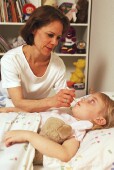
MONDAY, Feb. 28 (HealthDay News) — Few things send a parent’s fears soaring as quickly as a child’s rapidly rising temperature.
But, a new report from the American Academy of Pediatrics (AAP) attempts to allay those fears by reminding parents that a fever is usually just the body’s natural response against illness, and that lowering a fever may actually prolong an illness.
The AAP recommends that, in general, parents only treat a fever if it’s making their child feel uncomfortable.
“Fever is one of the most common reasons that parents contact pediatricians and health-care providers. Parents have concerns, and there are a lot of myths about bad things that can happen with a fever,” said the report’s lead author, Dr. Janice Sullivan, a professor of pediatric clinical care and clinical pharmacology at the University of Louisville School of Medicine and Kosair Children’s Hospital, in Kentucky.
“Sometimes, parents think that if they treat a fever that their child will get better faster, but fever is a sign of illness, and it’s the body’s way of slowing the germs down to help get rid of them. Fever is one of the triggers that your body uses to produce more white cells. If you bring a fever down, your child may not produce as many white cells to fight the infection,” she explained.
“Families need to remember that when a child has a fever, it’s a symptom, not the primary problem. Fever may be beneficial, so parents should really look at what’s causing the fever, not the fever itself,” suggested Dr. Basil Zitelli, a pediatrician at Children’s Hospital of Pittsburgh.
The AAP report, which is published in the March issue of Pediatrics, suggests that instead of focusing on the number on the thermometer, parents should let their child’s behavior be a guide for whether or not to give fever-reducing medications.
“If your child is eating and drinking well, and still engaged in some activities — though they may not be as active as normal — and doesn’t seem particularly uncomfortable, why take away a natural defense mechanism?” said Zitelli.
On the other hand, if your child seems lethargic and generally uncomfortable, fever-reducing medications, such as acetaminophen (Tylenol) or ibuprofen (Advil, Motrin) may make your child feel a little better. Give these medications as directed by the package or your pediatrician, based on your child’s age and weight.
However, the AAP recommends caution when administering these products, as serious, and even life-threatening, overdoses can occur. And, Sullivan said that previous research has shown that about half of parents don’t give their children the correct dose of medication.
Some health-care practitioners have begun recommended that parents alternate the use of these medications, but the AAP said there currently isn’t sufficient evidence to either recommend or discourage the use of this practice. But, it did express concern that parents might not receive or fully understand the more complicated dosing regimen required when alternating medications.
Sullivan said that it’s important that parents don’t give their children adult formulations of anti-fever drugs, even if they attempt to break tablets up to provide the correct dose. “It’s important to use the appropriate medication for the child’s age, and to use the appropriate measuring device,” said Sullivan.
The AAP report also reminds parents not to give aspirin to children, as its use has been associated with the development of a potentially life-threatening condition called Reye syndrome. The AAP also recommends against alcohol baths for cooling — too much alcohol can be absorbed through the skin.
Sullivan said that during well-child visits, parents should have discussion with their pediatricians about what to do when a child becomes ill. And, they should be given advice about when they should call their child’s doctor.
In general, she said, parents should alert their child’s doctor if:
- An infant is under 3 months old and has a fever of 100.4 F or above.
- An infant between 3 and 6 months old has a fever of 101.5 F or more.
- An older child has a fever of 103 degrees Fahrenheit or higher.
- Any child has a fever accompanied by lethargy, headache, skin rash, trouble breathing or dehydration.
More information
Learn more about fever from the Nemours Foundation.

